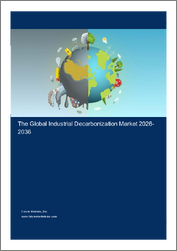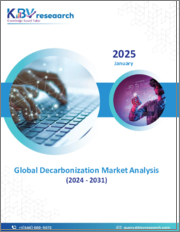
|
시장보고서
상품코드
1538546
탈탄소화 시장 보고서 : 동향, 예측 및 경쟁 분석(-2030년)Decarbonization Market Report: Trends, Forecast and Competitive Analysis to 2030 |
||||||
탈탄소화 동향 및 전망
세계 탈탄소화 시장은 2024년부터 2030년까지 연평균 11.8%의 성장률을 보일 것으로 예상됩니다. 이 시장의 주요 촉진요인은 탄소 배출에 따른 비용 절감을 위한 탈탄소 기술에 대한 투자 증가, 기후 변화의 영향에 대한 인식 증가, 세계 배출 기준의 강화 등입니다. 석유 및 가스, 에너지 및 유틸리티, 농업, 정부, 자동차 및 운송, 항공우주 및 방위 산업, 제조업 등의 시장에서의 기회로 인해 세계 탈탄소화 시장의 미래는 유망합니다.
부문별 탈탄소화
이 조사에는 세계 탈탄소화에 대한 서비스별, 기술별, 전개별, 최종 용도별, 지역별 예측이 포함되어 있습니다.
탈탄소화 시장 인사이트
Lucintel은 예측 기간 동안 지속가능한 운송 서비스가 가장 큰 부문으로 남을 것으로 예측했습니다.
이 시장에서 석유와 가스는 여전히 가장 큰 부문입니다.
북미는 녹색 환경에 초점을 맞춘 자금과 프로젝트가 증가함에 따라 예측 기간 동안 가장 큰 지역으로 남을 것입니다.
자주 묻는 질문
Q1. 시장 성장 예측은?
A1. 세계 탈탄소화 시장은 2024년부터 2030년까지 연평균 11.8%의 성장률을 보일 것으로 예상됩니다.
Q2. 시장 성장에 영향을 미치는 주요 촉진요인은?
A2. 이 시장의 주요 촉진요인은 탄소 배출 관련 비용을 줄이기 위해 탈탄소 기술에 대한 투자 증가, 기후 변화의 영향에 대한 인식 증가, 세계 배출 기준의 강화입니다.
Q3. 시장의 주요 부문은?
A3. 세계 탈탄소화 시장의 미래는 석유 및 가스, 에너지 및 유틸리티, 농업, 정부, 자동차 및 운송, 항공우주 및 방위 산업, 제조업 등 다양한 시장에서의 기회로 인해 유망합니다.
Q4. 시장의 주요 기업은?
A4. 주요 탈탄소화 기업은 다음과 같습니다.
- Deloitte
- IBM
- Atos
- Accenture
- Siemens
- SAP
- EcoAct
- GE DIGITAL
- Dakota Software
- EnergyCap
Q5. 향후 가장 큰 시장 부문은?
A5. Lucintel은 지속가능한 운송 서비스가 예측 기간 동안 가장 큰 부문으로 남을 것으로 예상하고 있습니다.
Q6. 시장에서 향후 5년간 가장 큰 시장이 될 것으로 예상되는 지역은?
A6. 북미는 녹색 환경에 초점을 맞춘 자금과 프로젝트가 증가함에 따라 예측 기간 동안 가장 큰 지역으로 남을 것입니다.
Q7. 보고서 사용자 정의가 가능합니까?
A7. 예, Lucintel은 추가 비용없이 10%의 사용자 정의를 제공합니다.
목차
제1장 주요 요약
제2장 세계의 탈탄소화 시장 : 시장 역학
- 소개, 배경, 분류
- 공급망
- 업계 성장 촉진요인과 과제
제3장 2018년부터 2030년까지 시장 동향과 예측 분석
- 거시경제 동향(2018-2023년)과 예측(2024-2030년)
- 세계의 탈탄소화 시장 동향(2018-2023년)과 예측(2024-2030년)
- 서비스별 세계탈탄소화 시장
- 탄소 회계· 보고 서비스
- 지속가능 수송 서비스
- 폐기물 절감·순환경제 서비스
- 기술별 세계의 탈탄소화 시장
- 재생에너지 기술
- 에너지 절약 솔루션
- 전기자동차
- 탄소 제거 기술
- 탄소 포집 및 저장
- 전개별 세계의 탈탄소화 시장
- 온프레미스
- 클라우드
- 최종 용도별 세계의 탈탄소화 시장
- 석유 및 가스
- 에너지·유틸리티
- 농업
- 정부
- 자동차·수송
- 항공우·방위
- 제조업
- 기타
제4장 2018년부터 2030년까지 지역별 시장 동향과 예측 분석
- 지역별 세계의 탈탄소화 시장
- 북미의 탈탄소화 시장
- 유럽의 탈탄소화 시장
- 아시아태평양의 탈탄소화 시장
- 기타 지역탈탄소화 시장
제5장 경쟁 분석
- 제품 포트폴리오 분석
- 업무 통합
- Porter's Five Forces 분석
제6장 성장 기회와 전략 분석
- 성장 기회 분석
- 서비스별 세계의 탈탄소화 시장 성장 기회
- 기술별 세계의 탈탄소화 시장 성장 기회
- 전개별 세계의 탈탄소화 시장 성장 기회
- 최종 용도별 세계의 탈탄소화 시장 성장 기회
- 지역별 세계의 탈탄소화 시장 성장 기회
- 세계의 탈탄소화 시장의 최신 동향
- 전략 분석
- 신제품 개발
- 세계의 탈탄소화 시장 생산능력 확대
- 세계의 탈탄소화 시장 합병, 인수, 합작투자
- 인증과 라이선싱
제7장 주요 기업 개요
- Deloitte
- IBM
- Atos
- Accenture
- Siemens
- SAP
- EcoAct
- GE DIGITAL
- Dakota Software
- EnergyCap
Decarbonization Trends and Forecast
The future of the global decarbonization market looks promising with opportunities in the oil & gas, energy & utility, agriculture, government, automotive & transportation, aerospace & defense, and manufacturing markets. The global decarbonization market is expected to grow with a CAGR of 11.8% from 2024 to 2030. The major drivers for this market are increasing investment in decarbonization technologies to reduce costs associated with carbon emissions, growing awareness of the effects of climate change, and stricter emissions standards across the world.
A more than 150-page report is developed to help in your business decisions. Sample figures with some insights are shown below.
Decarbonization by Segment
The study includes a forecast for the global decarbonization by services, technology, deployment, end use, and region.
Decarbonization Market by Services [Shipment Analysis by Value from 2018 to 2030]:
- Carbon Accounting & Reporting Services
- Sustainable Transportation Services
- Waste Reduction & Circular Economy Services
Decarbonization Market by Technology [Shipment Analysis by Value from 2018 to 2030]:
- Renewable Energy Technologies
- Energy Efficiency Solutions
- Electric Vehicles
- Carbon Removal Technologies
- Carbon Capture and Storage
Decarbonization Market by Deployment [Shipment Analysis by Value from 2018 to 2030]:
- On-Premises
- Cloud
Decarbonization Market by End Use [Shipment Analysis by Value from 2018 to 2030]:
- Oil & Gas
- Energy & Utility
- Agriculture
- Government
- Automotive & Transportation
- Aerospace & Defense
- Manufacturing
- Others
Decarbonization Market by Region [Shipment Analysis by Value from 2018 to 2030]:
- North America
- Europe
- Asia Pacific
- The Rest of the World
List of Decarbonization Companies
Companies in the market compete on the basis of product quality offered. Major players in this market focus on expanding their manufacturing facilities, R&D investments, infrastructural development, and leverage integration opportunities across the value chain. With these strategies decarbonization companies cater increasing demand, ensure competitive effectiveness, develop innovative products & technologies, reduce production costs, and expand their customer base. Some of the decarbonization companies profiled in this report include-
- Deloitte
- IBM
- Atos
- Accenture
- Siemens
- SAP
- EcoAct
- GE DIGITAL
- Dakota Software
- EnergyCap
Decarbonization Market Insights
Lucintel forecasts that sustainable transportation service will remain the largest segment over the forecast period.
Within this market, oil & gas will remain the largest segment.
North America will remain the largest region over the forecast period due to the increasing amount of funds and projects focused on green environment.
Features of the Global Decarbonization Market
Market Size Estimates: Decarbonization market size estimation in terms of value ($B).
Trend and Forecast Analysis: Market trends (2018 to 2023) and forecast (2024 to 2030) by various segments and regions.
Segmentation Analysis: Decarbonization market size by services, technology, deployment, end use, and region in terms of value ($B).
Regional Analysis: Decarbonization market breakdown by North America, Europe, Asia Pacific, and Rest of the World.
Growth Opportunities: Analysis of growth opportunities in different services, technology, deployment, end use, and regions for the decarbonization market.
Strategic Analysis: This includes M&A, new product development, and competitive landscape of the decarbonization market.
Analysis of competitive intensity of the industry based on Porter's Five Forces model.
FAQ
Q1. What is the growth forecast for decarbonization market?
Answer: The global decarbonization market is expected to grow with a CAGR of 11.8% from 2024 to 2030.
Q2. What are the major drivers influencing the growth of the decarbonization market?
Answer: The major drivers for this market are increasing investment in decarbonization technologies to reduce costs associated with carbon emissions, growing awareness of the effects of climate change, and stricter emissions standards across the world.
Q3. What are the major segments for decarbonization market?
Answer: The future of the global decarbonization market looks promising with opportunities in the oil & gas, energy & utility, agriculture, government, automotive & transportation, aerospace & defense, and manufacturing markets.
Q4. Who are the key decarbonization market companies?
Answer: Some of the key decarbonization companies are as follows:
- Deloitte
- IBM
- Atos
- Accenture
- Siemens
- SAP
- EcoAct
- GE DIGITAL
- Dakota Software
- EnergyCap
Q5. Which decarbonization market segment will be the largest in future?
Answer: Lucintel forecasts that sustainable transportation service will remain the largest segment over the forecast period.
Q6. In decarbonization market, which region is expected to be the largest in next 5 years?
Answer: North America will remain the largest region over the forecast period due to the increasing amount of funds and projects focused on green environment.
Q7. Do we receive customization in this report?
Answer: Yes, Lucintel provides 10% customization without any additional cost.
This report answers following 11 key questions:
- Q.1. What are some of the most promising, high-growth opportunities for the decarbonization market by services (carbon accounting & reporting services, sustainable transportation services, and waste reduction & circular economy services), technology (renewable energy technologies, energy efficiency solutions, electric vehicles, carbon removal technologies, and carbon capture and storage), deployment (on-premises and cloud), end use (oil & gas, energy & utility, agriculture, government, automotive & transportation, aerospace & defense, manufacturing, and others), and region (North America, Europe, Asia Pacific, and the Rest of the World)?
- Q.2. Which segments will grow at a faster pace and why?
- Q.3. Which region will grow at a faster pace and why?
- Q.4. What are the key factors affecting market dynamics? What are the key challenges and business risks in this market?
- Q.5. What are the business risks and competitive threats in this market?
- Q.6. What are the emerging trends in this market and the reasons behind them?
- Q.7. What are some of the changing demands of customers in the market?
- Q.8. What are the new developments in the market? Which companies are leading these developments?
- Q.9. Who are the major players in this market? What strategic initiatives are key players pursuing for business growth?
- Q.10. What are some of the competing products in this market and how big of a threat do they pose for loss of market share by material or product substitution?
- Q.11. What M&A activity has occurred in the last 5 years and what has its impact been on the industry?
Table of Contents
1. Executive Summary
2. Global Decarbonization Market : Market Dynamics
- 2.1: Introduction, Background, and Classifications
- 2.2: Supply Chain
- 2.3: Industry Drivers and Challenges
3. Market Trends and Forecast Analysis from 2018 to 2030
- 3.1. Macroeconomic Trends (2018-2023) and Forecast (2024-2030)
- 3.2. Global Decarbonization Market Trends (2018-2023) and Forecast (2024-2030)
- 3.3: Global Decarbonization Market by Services
- 3.3.1: Carbon Accounting & Reporting Services
- 3.3.2: Sustainable Transportation Services
- 3.3.3: Waste Reduction & Circular Economy Services
- 3.4: Global Decarbonization Market by Technology
- 3.4.1: Renewable Energy Technologies
- 3.4.2: Energy Efficiency Solutions
- 3.4.3: Electric Vehicles
- 3.4.4: Carbon Removal Technologies
- 3.4.5: Carbon Capture and Storage
- 3.5: Global Decarbonization Market by Deployment
- 3.5.1: On-premises
- 3.5.2: Cloud
- 3.6: Global Decarbonization Market by End Use
- 3.6.1: Oil & Gas
- 3.6.2: Energy & Utility
- 3.6.3: Agriculture
- 3.6.4: Government
- 3.6.5: Automotive & Transportation
- 3.6.6: Aerospace & Defense
- 3.6.7: Manufacturing
- 3.6.8: Others
4. Market Trends and Forecast Analysis by Region from 2018 to 2030
- 4.1: Global Decarbonization Market by Region
- 4.2: North American Decarbonization Market
- 4.2.1: North American Decarbonization Market by Services: Carbon Accounting & Reporting Services, Sustainable Transportation Services, and Waste Reduction & Circular Economy Services
- 4.2.2: North American Decarbonization Market by End Use: Oil & Gas, Energy & Utility, Agriculture, Government, Automotive & Transportation, Aerospace & Defense, Manufacturing, and Others
- 4.3: European Decarbonization Market
- 4.3.1: European Decarbonization Market by Services: Carbon Accounting & Reporting Services, Sustainable Transportation Services, and Waste Reduction & Circular Economy Services
- 4.3.2: European Decarbonization Market by End Use: Oil & Gas, Energy & Utility, Agriculture, Government, Automotive & Transportation, Aerospace & Defense, Manufacturing, and Others
- 4.4: APAC Decarbonization Market
- 4.4.1: APAC Decarbonization Market by Services: Carbon Accounting & Reporting Services, Sustainable Transportation Services, and Waste Reduction & Circular Economy Services
- 4.4.2: APAC Decarbonization Market by End Use: Oil & Gas, Energy & Utility, Agriculture, Government, Automotive & Transportation, Aerospace & Defense, Manufacturing, and Others
- 4.5: ROW Decarbonization Market
- 4.5.1: ROW Decarbonization Market by Services: Carbon Accounting & Reporting Services, Sustainable Transportation Services, and Waste Reduction & Circular Economy Services
- 4.5.2: ROW Decarbonization Market by End Use: Oil & Gas, Energy & Utility, Agriculture, Government, Automotive & Transportation, Aerospace & Defense, Manufacturing, and Others
5. Competitor Analysis
- 5.1: Product Portfolio Analysis
- 5.2: Operational Integration
- 5.3: Porter's Five Forces Analysis
6. Growth Opportunities and Strategic Analysis
- 6.1: Growth Opportunity Analysis
- 6.1.1: Growth Opportunities for the Global Decarbonization Market by Services
- 6.1.2: Growth Opportunities for the Global Decarbonization Market by Technology
- 6.1.3: Growth Opportunities for the Global Decarbonization Market by Deployment
- 6.1.4: Growth Opportunities for the Global Decarbonization Market by End Use
- 6.1.5: Growth Opportunities for the Global Decarbonization Market by Region
- 6.2: Emerging Trends in the Global Decarbonization Market
- 6.3: Strategic Analysis
- 6.3.1: New Product Development
- 6.3.2: Capacity Expansion of the Global Decarbonization Market
- 6.3.3: Mergers, Acquisitions, and Joint Ventures in the Global Decarbonization Market
- 6.3.4: Certification and Licensing
7. Company Profiles of Leading Players
- 7.1: Deloitte
- 7.2: IBM
- 7.3: Atos
- 7.4: Accenture
- 7.5: Siemens
- 7.6: SAP
- 7.7: EcoAct
- 7.8: GE DIGITAL
- 7.9: Dakota Software
- 7.10: EnergyCap
(주말 및 공휴일 제외)


















